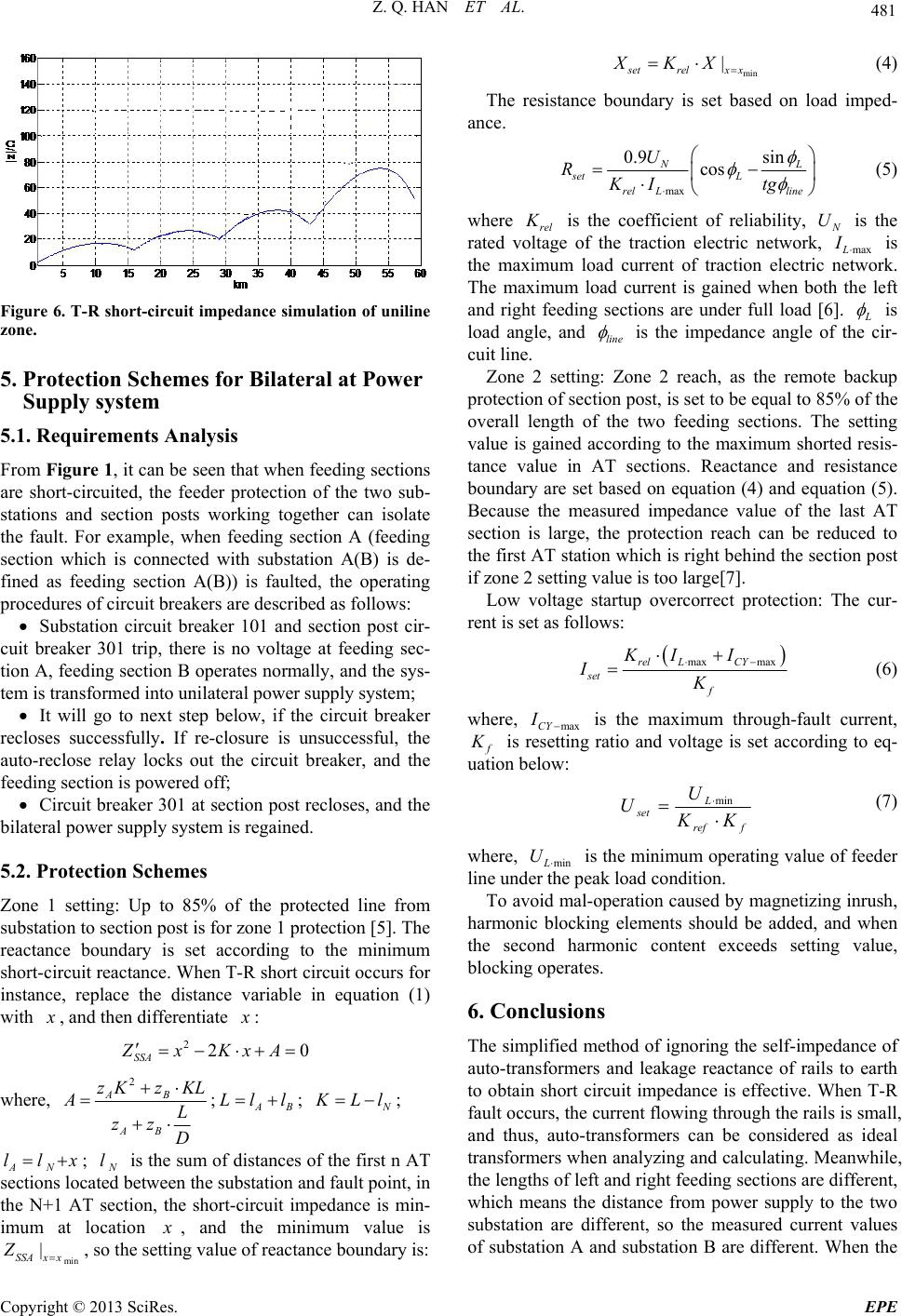
Z. Q. HAN ET AL. 481
Figure 6. T-R short-circuit impedance simulation of uniline
zone.
5. Protection Schemes for Bilateral at Power
Supply system
5.1. Requirements Analysis
From Figure 1, it can be seen that when feeding sections
are short-circuited, the feeder protection of the two sub-
stations and section posts working together can isolate
the fault. For example, when feeding section A (feeding
section which is connected with substation A(B) is de-
fined as feeding section A(B)) is faulted, the operating
procedures of circuit breakers are described as follows:
Substation circuit breaker 101 and section post cir-
cuit breaker 301 trip, there is no voltage at feeding sec-
tion A, feeding section B operates normally, and the sys-
tem is transformed into unilateral power supply syste m;
It will go to next step below, if the circuit breaker
recloses successfully. If re-closure is unsuccessful, the
auto-reclose relay locks out the circuit breaker, and the
feeding section is powered off;
Circuit breaker 301 at section po st recloses, and the
bilateral power supply system is rega ined.
5.2. Protection Schemes
Zone 1 setting: Up to 85% of the protected line from
substation to section post is for zone 1 protection [5]. The
reactance boundary is set according to the minimum
short-circuit reactance. When T-R short circuit occurs for
instance, replace the distance variable in equation (1)
with
, and then differentiate
:
220
SSA
ZxKxA
where, 2
AB
AB
zKzKL
AL
zz
D
;AB
Ll l
;
Ll
x
;
AN
; ll
l is the sum of distances of the first n AT
sections located between the substation and fault point, in
the N+1 AT section, the short-circuit impedance is min-
imum at location
, and the minimum value is
, so the setting value of reactance boundary is:
min
|
SSAx x
Z
min
|
setrelx x
XKX
(4)
The resistance boundary is set based on load imped-
ance.
max
0.9 sin
cos
NL
set L
relLline
U
RKI tg
(5)
where rel
is the coefficient of reliability,
UI
is the
rated voltage of the traction electric network, maxL is
the maximum load current of traction electric network.
The maximum load current is gained when both the left
and right feeding sections are under full load [6].
is
load angle, and line
is the impedance angle of the cir-
cuit line.
Zone 2 setting: Zone 2 reach, as the remote backup
protection of section post, is set to be equal to 85% of the
overall length of the two feeding sections. The setting
value is gained according to the maximum shorted resis-
tance value in AT sections. Reactance and resistance
boundary are set based on equation (4) and equation (5).
Because the measured impedance value of the last AT
section is large, the protection reach can be reduced to
the first AT station which is right behind the section post
if zone 2 setting value is too large[7].
Low voltage startup overcorrect protection: The cur-
rent is set as follows:
max maxrel LCY
set f
KI I
IK
(6)
where, maxCY is the maximum through-fault current, I
is resetting ratio and voltage is set according to eq-
uation below:
fref
L
set KK
U
U
min (7)
where, minL is the minimum operating value of feeder
line under the peak load condition.
U
To avoid mal-operation caused by magnetizing inrush,
harmonic blocking elements should be added, and when
the second harmonic content exceeds setting value,
blockin g operates.
6. Conclusions
The simplified method of ignoring the self-impedance of
auto-transformers and leakage reactance of rails to earth
to obtain short circuit impedance is effective. When T-R
fault occurs, the current flowing through the rails is small,
and thus, auto-transformers can be considered as ideal
transformers when analyzing and calculating. Meanwhile,
the lengths of left and right feeding sections are different,
which means the distance from power supply to the two
substation are different, so the measured current values
of substation A and substation B are different. When the
Copyright © 2013 SciRes. EPE